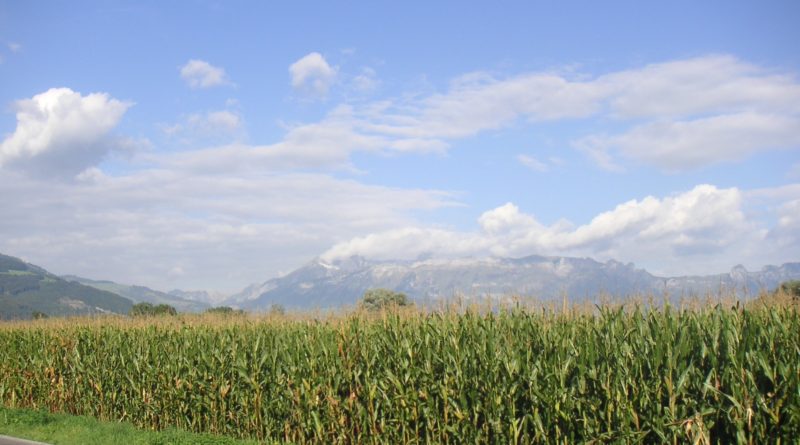The Green Revolution is not so Green: How modern agriculture affects the climate
Photo by Paranoid
Article by Hannah Klaus
Step into any supermarket and the success of the “green revolution” will be apparent. There is a bounty of food from all around the globe. Produce is stacked high even if it is not in season.
A closer look, however, reveals that there are some major flaws in the way we produce food. Modern agriculture is contributing to climate change as it is energy intensive and relies heavily on the use of fossil fuels. When considering the agricultural sector as a whole, the cumulative effect of each step in the process of growing an ear of corn and getting it to a kitchen table is strikingly significant.
The green revolution spread worldwide in the 1960s when a number of agricultural techniques spread across the world that are effective in maximizing crop yield. The outcome was a decrease in crop diversity as varieties that are more responsive to fertilizers or have a higher yield were subsidized and grown on a massive scale. Additionally, this green revolution initiated the mass use of chemical pesticides and more intensive water use for irrigation (5).
A key part of modern agricultural is monoculture, or the practice of growing single crops intensively on a large scale. Crops that are commonly grown through agriculture include corn, wheat, soybeans, cotton, and rice. Growing the same crop year after year depletes the quality of the soil so this practice requires large amounts of chemicals products including synthetic fertilizers and pesticides. When the soil is depleted, it becomes vulnerable to erosion (3). The fertilizer, which is high in nutrients including nitrogen and phosphorus, runs off into nearby waterways, resulting in eutrophication. Eutrophication occurs when agriculture run off increases the concentration of critical nutrients in waterways leads to the rapid growth of algae. This algae growth blocks sunlight from reaching the bottom of the waterway and when the algal dies, decomposers consume the dead algal and dissolved oxygen is depleted, resulting in fish kills (4). The new, high-yield crops introduced during the green revolution require more intensive irrigation that native varieties. For example, high-yielding wheat requires 30 percent more water than traditional varieties. Modern agricultural practices use up a large part of water resources during a time when there are conflicts over diminishing water resources internationally (5).
A common practice in meat industry is preparing animals to be slaughtered in large-scale warehouses called confined animal feeding operations (CAFOs). Here animals are fed a high calorie diet often consisting of grains supplemented with antibiotics and hormones so that they will become as large as possible before slaughter. CAFOs contribute more to global climate change than the entire transportation industry, worldwide. The Food and Agriculture Organization of the United Nations reported that animal agriculture accounts for 18 percent of all anthropogenic greenhouse gas emissions. A particularly harmful greenhouse gas releases from CAFOs is methane, which is 70 times more damaging per ton to the atmosphere than carbon dioxide. The antibiotics fed to animals often runs off into nearby water supplies (1). Not only is this method of farming unsustainable for the environment, it is also not an efficient or responsible use of resources. Feeding the confined animal actually uses more food than it uses. This is an issue when one in nine people worldwide do not have enough food to live a healthy lifestyle (2).
Some scientists have suggested that it is time for a “second” green revolution that is more sustainable and will minimize agriculture’s impact on the climate (6). Small-scale agriculture is a sustainable and more climate-friendly alternative to current practices. This farming technique uses low-level technology and indigenous varieties, and serves a local market. By only planting crops that naturally grow well in a given area, chemical pesticides often won’t be necessary and lighter water resources will be required to keep the crops healthy. Without the pressure to maximize crop yields to provide food for a large consumer base, farmers do not need to use monocropping and can more easily maintain the quality. Additionally, small-scale farming contributes to global food security. Families running the farms have access to food on a consistent basis (7).
- Cummins, Ronnie. “How Factory Farming Contributes to Global Warming.” EcoWatch. January 21, 2013. Accessed October 12, 2016. http://www.ecowatch.com/how-factory-farming-contributes-to-global-warming-1881690535.html.
2.”Hunger Statistics | WFP | United Nations World Food Programme – Fighting Hunger Worldwide.” Hunger Statistics | WFP | United Nations World Food Programme – Fighting Hunger Worldwide. Accessed October 12, 2016. https://www.wfp.org/hunger/stats.
3.”Industrial Agriculture.” Union of Concerned Scientists. Accessed October 12, 2016. http://www.ucsusa.org/our-work/food-agriculture/our-failing-food-system/industrial-agriculture#.V_1vQpMrLEY.
4.”NOAA’s National Ocean Service Education: Estuaries.” US Department of Commerce, National Oceanic and Atmospheric Administration. Accessed October 12, 2016. http://oceanservice.noaa.gov/education/kits/estuaries/media/supp_estuar09b_eutro.html.
- Shiva, Vandana. “The Green Revolution in the Punjab.” The Green Revolution in the Punjab. 1991. Accessed October 12, 2016. http://livingheritage.org/green-revolution.htm.
- Singh. “A Second Green Revolution?” ICARDA. May 5, 2013. Accessed October 12, 2016. http://www.icarda.org/features/second-green-revolution.
- Stone, Andrea. “Family Farmers Hold Keys to Agriculture in a Warming World | Nat Geo Food.” National Geographic. May 3, 2014. Accessed October 12, 2016. http://news.nationalgeographic.com/news/2014/05/140502-climate-change-agriculture-family-farm-science/.


I love to read your articles. Here are so many interesting things about the green revolution. Thanks and keep sharing.
It is very bad because it has not many points